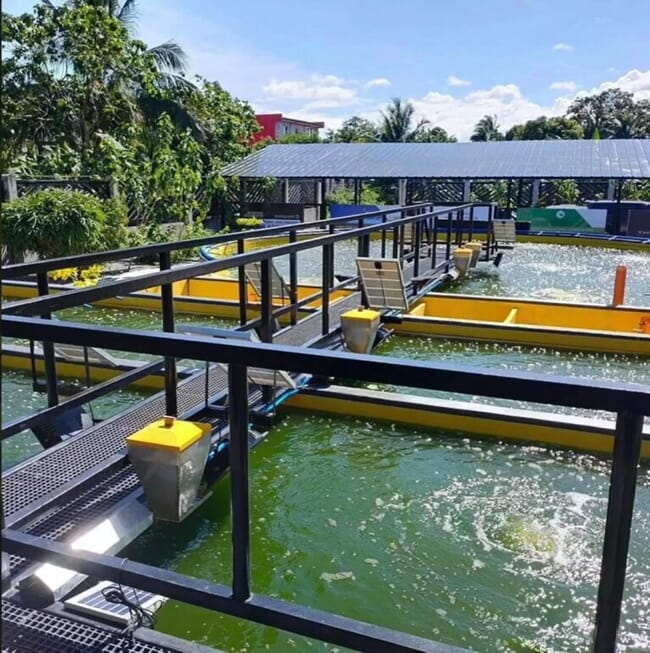
© AR Francis Neil Quijano
Modern urban fish farms take on a much smaller footprint but can achieve 58 times the production of traditional farms. Traditional farms may produce 34 metric tonnes of fish per hectare a year, but with the right technology, next-generation farms can harvest as much as 2,000 tonnes per hectare annually in an indoor, climate-proof, biosecure and zero antibiotic environment.
Smart farms are also more energy efficient. A kilogram of fish may take only 1.5 kilowatts of electricity to produce while conventional systems may use 25 to 30 kilowatts. Recent advances in genetics, nutrition and other techniques further the capacity of farms to produce more with less.
However, the use of modern equipment and the most recent technologies might not be for everyone. An aquaculture expert cautioned that to succeed, fish farmers must first understand the cost of technology implementation.
Aquaculture “is a very bottom-line-driven industry,” said Matthew Tan, associate professor in aquaculture at James Cook University and Singapore’s private sector representative to the APEC Policy Partnership on Food Security.
In a lecture, Professor Tan said fish farmers should understand financial modelling before moving up to Aquaculture 4.0, fish farming’s adaptation of the fourth industrial revolution (Industry 4.0) defined by the current trend of smart automation, interconnectivity and other disruptive technologies.
Professor Tan spoke during the 28th Dean Domiciano K Villaluz Memorial Lecture of SEAFDEC/AQD.
“First look at the market, who is buying? What is the price of the fish? What is the cost of technology implementation?” he advised.
Counting the costs
Professor Tan added that for every additional upgrade in equipment or technology, the additional cost must be considered to determine whether it is worth pursuing or not. “It must make financial sense in order to implement it,” he said.

© Jala
As an example, he cites his experience operating an abalone hatchery in China where his cost of production for one “baby abalone” was three to four cents. “If my cost of implementation of a technology… cost me another four cents, that means it cost me eight cents to produce one baby abalone. I won’t use it because my selling price is only six to seven cents.”
“The cost of production must get lower, while you maintain your offtake price or selling price, then the technology will work for you in the space you are operating in,” Professor Tan adds.
On the other hand, he says high initial investments in modern aquaculture “…can make more financial sense.” Professor Tan is currently working on super-intensive indoor shrimp farms that he acknowledges are more expensive to set-up than open ponds. But considering the risk of shrimp disease outbreaks, the highly-biosecure enclosed systems can be a better option.
To compete with shrimp produced in the open pond system, Professor Tan’s team computed that they need to produce at least 15 kilograms of vannamei shrimp per cubic metre, which then becomes their target. Meanwhile, open pond farmers can produce between 3 and 5 kilograms per cubic metre, assuming no diseases affect the stocks.
“The open pond farmers always think that they are much cheaper, but if they take into account all the losses when the disease strikes them, they find that they’re actually losing a lot more,” Professor Tan said.
New technology and collaboration
Another speaker during the lecture also explained how new technology and equipment can reduce the costs of electricity, particularly in the Philippines where power-intensive recirculating aquaculture systems (RAS) are struggling to take off.
“In the Philippines, we’ve been using the old technology, for example we’re using roots blower, minimum of one horsepower which is what 745 watts,” said Francis Neil Quijano, an architect who is behind Agritektura, a multi-disciplinary movement aiming to transform communities.
He said he is now using a better energy-efficient aquapump that consumes only around 165 watts and that could make recirculating aquaculture systems more viable. Quijano says that while fish farmers are still using 1990s technologies, he encountered more up-to-date technologies, introduced as late as 2020, by working with other professionals including those from outside the Philippines.
“Let’s start with working with people, working with different professionals… it’s not just modern aquaculturists, but architects, engineers, researchers,” he added.
Quijano spoke in the lecture about how, in response to the Covid-19 pandemic, Agritektura developed modular aquaculture systems using RAS with automated aeration, filtration and nutrition systems to boost aquaculture in Philippine communities.
“Let’s be open to technology and I know it will work in the Philippines,” he said, particularly referring to equipment and infrastructure. “Perhaps we can explore more, study, and just be open. Old systems will not work.”




